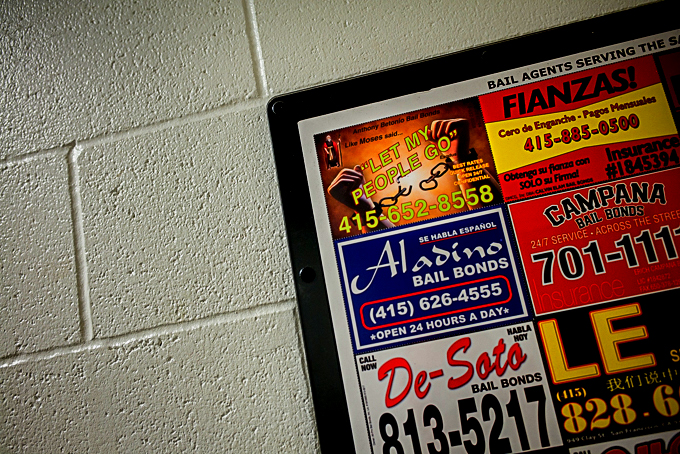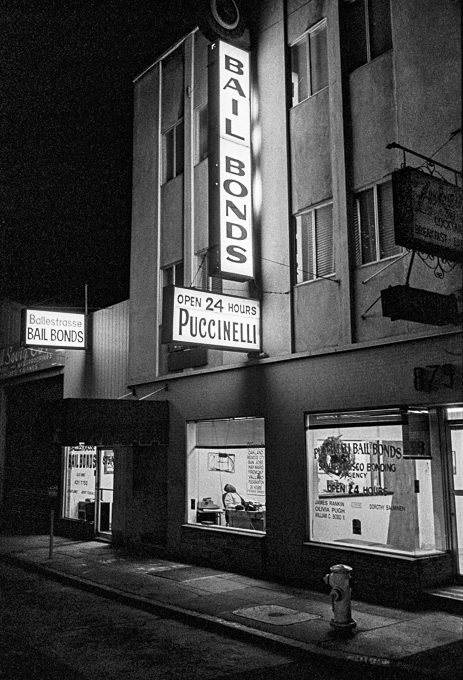Jail-n-Bail
By Eileen Hirst

If you live in California, you will have an opportunity on November 3 to decide whether or not to replace the state’s cash bail system with a pretrial risk assessment tool that measures an individual’s likelihood of returning to court for trial and provides supervision to encourage compliance. Your yes vote on Proposition 25 means you believe, as I do, that the cash bail system is arbitrary and discriminatory because it keeps economically disadvantaged people, most of whom are people of color, in jail, charged with the same crimes for which wealthy people can buy their release.
If that is not reason enough, here is another reason for voting yes. It just might be that the end of the cash bail system will also spell the end of those obnoxious jail-n-bail fundraisers so popular among charities that really should know better.
Jail-n-bail, at least according to coolfundraisingideas.net, is “one of the best fundraisers of all time.” Here is how it works: You get a group of community luminaries – mayors, TV weather reporters, local sports heroes and people known primarily to readers of society pages – to volunteer to be “arrested” and taken to some event planner’s fantasy of what a jail looks like. They sit in the mock jail cell and dial up all their friends to solicit contributions until they raise enough money to “make bail.”
You think I’m kidding?
Jail-n-bail is a favorite of such mainstream charities as the American Cancer Society and the Leukemia and Lymphoma Society. They are also popular with smaller non-profits like the Down Syndrome Foundation of Southeastern New Mexico and the Cuyahoga County Animal Shelter in Valley View, Ohio, which urges you to “nominate yourself (or a friend) to come on down, be arrested, charged and sent to ‘jail’ with a four legged partner in crime while to scurry to ask friends and family to help you post bail!”
Websites abound with tips and tricks for successful jail-n-bails. Your event can be as simple as having your local celebrities – usually called jailbirds — gather in a public space to be “detained” in a cardboard cut-out jail cell for such offenses as refusing to smile for their driver’s license photo or showing off pictures of their grandchildren too often. Or, if you want to really put some time into it, you can issue fake wanted posters and fake arrest warrants. You can call your local police department’s community services department and order up real law enforcement officers to go to the workplaces of your volunteer arrestees, handcuff them and take them away to jail. Oh, and it would be great to get a local judge to show up in a black robe, and don’t forget the gavel! This will be such a laugh riot that the judge will have to bang the gavel often to restore order. Hilarious!

I first heard of jail-n-bail when a prominent San Francisco charity called, hoping to interest my boss, Sheriff Michael Hennessey, in being a celebrity jailbird. Imagine that! The sheriff in jail! It will be so much fun! Can we borrow some orange jumpsuits?
The problem is, there is nothing funny about being in jail. Jail is where people who do not have wealthy friends to call for bail wait months and sometimes years for trial. Like many urban jail systems in the United States, San Francisco’s is the largest provider of mental health services in the city. A significant percentage of arrestees are dual-diagnosed, suffering addiction along with mental illness. The majority lack stable housing prior to arrest. Most cannot read above the fourth-grade level, coming as they do from housing projects in crime-ridden neighborhoods where they were raised by single parents or grandparents. There is great racial disparity in San Francisco, painfully evident in the jails. In a city where the Black population hovers around five percent, the Black population in the jail system only occasionally dips below fifty percent.
I stated all those facts to the caller and said, “Sheriff Hennessey does not think it is appropriate to make fun of people in those circumstances.”
That should have been the end of it, wouldn’t you think? But the next year and the year after and for years after that, the same charity called with the same request and the same refrain about how much fun it would be.
Did these people truly not understand that fake arresting someone for something as frivolous as having a bad hair day mocked real people, arrested for real crimes, and booked into custody? Did they have no compassion for the families thrown into turmoil and fear by the arrest of a son or daughter, a parent, a husband, a breadwinner?
No, they didn’t, because it never happened to them. Their understanding of being in custody seemed to be largely based on the image of the cheerful fellow depicted on a Monopoly get-out-of-jail-free card. On the rare occasion that the son of a middle-class or wealthy family did get arrested, the family attorney would often make it to the jail, bail slip in hand, before the arrestee even arrived to be booked. In the almost unheard of event that this individual could not make bail until arraignment, I could count on a call from his parents asking to visit outside of normal visiting hours so they would not have to stand in line in a drafty concrete stairwell at the Hall of Justice with everyone else waiting to visit a family member. “We’re not like them,” they would say.
Actually, they were exactly like them, at least in one regard. They were living through the devastating experience of having a loved one in custody. But that isn’t what they meant.
If you scroll through online images of people enjoying themselves at jail-n-bails you will notice several similarities among them. For one thing, these folks like costumes. They love dressing up in orange jail outfits or in black-and-white stripes, complete with matching caps, for their trip to fake jail. They all smile while assuming the position to be handcuffed, often with real handcuffs by a real law enforcement officer. They all smile for their fake mug shots.
And, they are all white people.
Well, all but three. In the more than one hundred images I looked at, only three included Black people. Two were shown in handcuffs and one appeared in a wanted poster.
Coolfundraisingideas.net gushes that jail-n-bails “work especially well as a sorority or fraternity fundraiser…” Tell that to Northwestern University’s Kappa Kappa Gamma sorority and Zeta Beta Tau fraternity whose 2014 jail-n-bail did not work so especially well. It was intended to raise money for a children’s literacy non-profit, certainly a worthy cause. But it begs the question, why not have a used book sale, or an author event, or a volunteer sign-up to teach kids to read? Something, anything that has to do with children’s literacy.
Because then you could not advertise it with a photograph of a blonde jailbird posed provocatively in a cute little orange dress fetchingly accessorized with a ball and chain cuffed to her bare leg, that’s why.
As reported by Campus Reform, and picked up by Fox News, many students took to social media to say they found the jail-n-bail offensive. One called out the use of orange jumpsuits as a symbol of a system that adversely impacts “the lives and literacy rates of black and brown children.”
Ajay Nadig, then a sophomore, nailed it in a letter to the editor of The Daily Northwestern. “(T)he fact that a group of wealthy Northwestern students are ‘play-acting’ at being prisoners (most of whom are poor) is a blatant belittling of the realities of mass incarceration and the prison-industrial complex.”
I wish I had said that.
To their credit, Zeta Beta Tau withdrew their support, “(f)ollowing the oversight of the racial and socioeconomic issues,” associated with it, and called their participation an “error in judgment.” The event was cancelled.
Unfortunately, that was not the end of student-sponsored jail-n-bails. Five years later, Fairfield University is still hosting an annual jail-n-bail to benefit the Special Olympics, and University of Connecticut held one this year for Habitat for Humanity.
Let’s turn this around for a moment. What would happen if a bunch of well-intentioned do-gooders proposed raising money for educational materials for jail inmates – not that anyone would – by requiring prominent people to play-act being special needs children. Or, to sit in a tent on a cold sidewalk and beg for quarters until they could score a shelter bed. What if they had to put on hospital gowns and get hooked up to fake chemotherapy until they raised enough money for a doctor to declare them cancer free?
You know what would happen. The outcry would be deafening. There would be national news stories denouncing the callousness and insensitivity of the organizers. Hosts at CNN and MSNBC and Fox would unite as one, sputtering to produce the right words to express their outrage at the cruelty of ridiculing disadvantaged people in such devastating circumstances. The boards of the Special Olympics and Habitat for Humanity and the American Cancer Society would write furious op-eds calling for a boycott.
So, why is it okay when these same people raise money for their causes by ridiculing the disadvantaged Black and Brown people who populate this country’s jails?
…
Thanks Eileen Hirst for exposing this practice. Makes me kinda sick.
Thank you Ellen for both your articles. They bring back a few memories, none very good. During my years in prison, we twice had visitors such as you described — once, when I was in a county jail, a group of teenagers were brought in to look at us as part of some sort of scared straight program — it was truly like being an animal in the zoo. Similarly, when in a federal prison, after word of some violence, police escorted community members onto the prison grounds to ensure them that they were safe. Again, there was a dehumanizing feel of being put on display.
But it is your description of charities using county jails to play act that really got to me — I was in one for a long time pre-trial, and others for briefer times when being transferred from spot to spot. They are places where so much human drama is taking place, with people facing harsh realities and often forced to make difficult, consequential decisions. Even in a life spent without knowing anyone “justice involved” it takes a highly developed lack of empathy to not even be able to see how such cavalier play-acting might look to those caught within its webs (or to family members looking on from outside).
An eye-opening, blood-boiling read. A look at a *charitable* socialite practice that exposes the different worlds in which rich and poor live.
Thanks to author Eileen Hirst